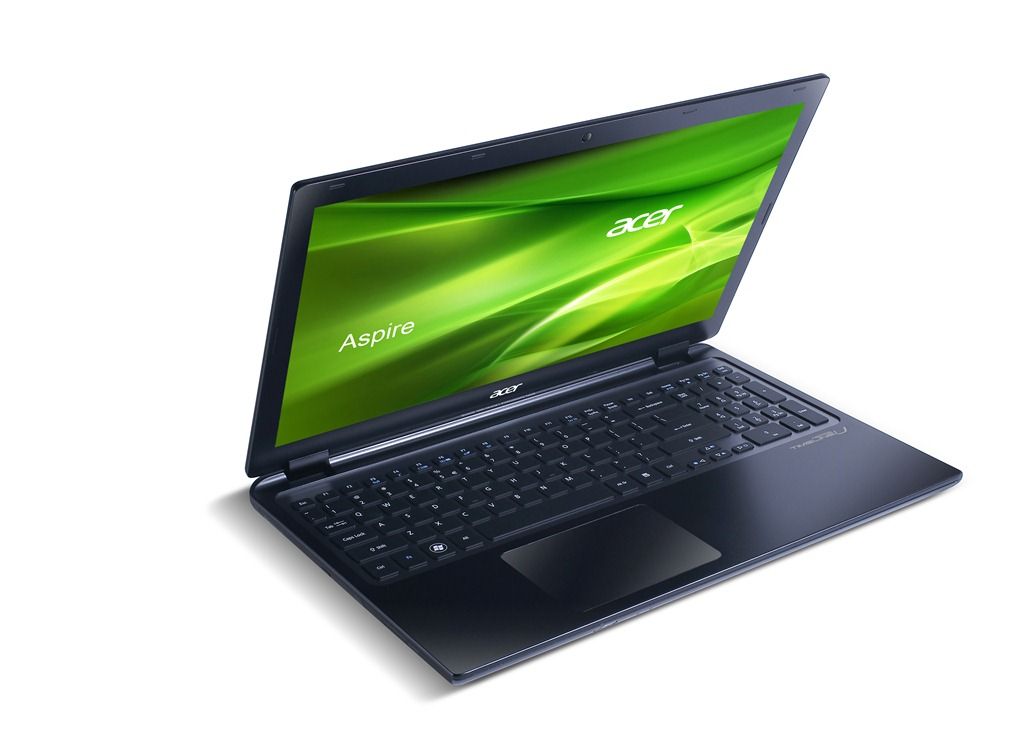
For those not familiar with Euro pricing, €599 for the Acer M3 (M3-581T-32364G34M) is a breakthrough for the Ultrabook segment. Average price for an Ultrabook in the European region is near €1000 with the lowest-priced offers down at around €700. To see a launch price of €599 is going to raise eyebrows across the industry because not only is the Acer M3 a cheap Ultrabook, it’s got some premium features too. But there’s a price to pay. This 15.6” chubber weighs 2.3KG!
I got hands-on with the Acer (Aspire Timeline Ultra M3-581TG) M3 at CeBIT last week (video below) and was surprised to see it labeled as an Ultrabook. I’ve double-checked and yes, it is officially an Ultrabook.
Full specifications are available but here are the key features.
- 15.6” screen
- DVD Writer
- Nvidia GT640M graphics
- 20mm think
- 2.2KG
- 500GB / 20GB hybrid hard drive
- 54Wh (estimated) battery. (4850mah, 3-cell)
But there are two specifications you really need to be careful of.
The €599 Acer M3 comes with a 320GB hard drive and a Core i3 CPU at 1.4Ghz with no Turbo boost. The more sensible choice, a Core i5 2467M which has a 500GB drive, will cost you €799. All models come with a 1366×768 resolution screen which, on a 15.6” size, is not impressive. A core i7 model with 256GB SSD is available for €1199. Note that there isn’t a Bluetooth module in the models we’ve seen in Europe.
Availability is said to be 5-6 weeks (via Acer Germany) so expect end of April general availability in Germany and, likely, other European countries. We don’t have availability for USA yet but we suspect it will be the same.
One thing to note – some specifications are listing the UM77 chipset. That’s a next-generation Ivy-Bridge focused chipset. Maybe there’s an upgrade planned for down the line.
More information on the Acer Aspire M3 here.
We’ve requested a review sample and look forward to some games testing soon!















What a joke. The term Ultrabook now includes a massive footprint at 15.6 inches and a super heavy weight of 2.3Kgs.
Real bullshit. Manufacturers are going haywire with no direction. No proper guidelines. Soon they will come out with a 17.3 inch ultrabook. At the end of the day, consumers suffer.
That’s a very high capacity for a 3 cell battery.
The whole category is supposed to be thin, light & highly mobile.
It’s indeed a joke to allow a 2.3kg machine to be called an “Ultrabook” and Intel is destroying the brand they’ve spent so much on by allowing it.
It IS a conscious decision by Intel, though as they paid for a study that concluded that the #1 problem preventing further adoption of ultrabooks (besides the price) is the fact that some people just wont’ give up bigger screens. -Intel’s response: try to ensure that 50% of the ultrabooks released this year have 14 & 15″ screens.
I don’t necessarily disagree with their decision to support 14 & 15″ screens BUT if they’re going to do this they need to add one more requirement for ultrabooks by size: Weight. They really can’t afford to wash down the Ultrabook brand by leaving weight completely unregulated in a product whose promise is “thin and light” and “mobility with power”.
They need to institute weight requirements ASAP; actually I think it’s far too late and they’ve now let the fat, ugly horse out of the barn.
Adam
Its true. Most US buyers are 15 inch buyers. but that is just the US. Globally, I think its a different story. The researches for Intel ie the marketing and survey people are probably too narrow minded to realise that the whole world isn’t just the US alone.
I would agree but fail to see how this matters when there will be a range of available models and that includes sizes.
So if you don’t want something this large then just get the size you do want instead.
While weight also often has to do with the price range of the system and the materials used to built it.
Natural selection will eventually weed out the models that don’t really compete well. While the weight will likely get better once they get to Haswell and more of these companies get better at designing them.
Though there is only so much they can do about the weight of the battery until battery technology improves and that’s likely to take a very long time.
Although I agree that this is taking the Ultrabook definition too far I would say it is a good thing that 15″ laptops like this one are sliming down (in terms of both weight and size). Especially given that (at least I hope) most versions are coming with the fairly powerful dedicated GPU for those who want gaming.
DM
This is nice for people who want thin 15″ notebooks and play games. Too bad I want a small 11.6″ notebook with great battery life. So far, I was completely wrong in getting excited over the ultrabook hype. It seems the main requirement of ultrabooks is “will I look cool at the coffee shop with this” metric.
Looks like I’ll just get the aging 11.6″ Samsung NP300 and buy one of those high capacity batteries for it. The footprint is almost as small as a 10.1″ netbook.
That is true. Eventually people will realise all this ultrabook nonsense is just maketing gimmick and go back to the traditional 11.6 notebook, which, far half the price, offers as good performance and as light as the ultrabook. Have you seen the Lenovo S206 and S200? They put the ultrabook to shame.
In what respect?
Hi Chippy,
While you are waiting/testing your new Acer M3, I did a review of more expensive one. Let me know if you like it: http://t.co/LP658rAg
It is US version, with Bluetooth, i5 and SSD+HDD hybrid combination.